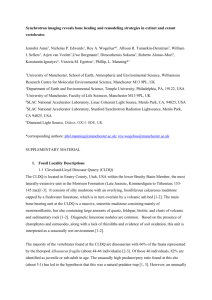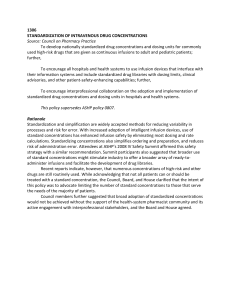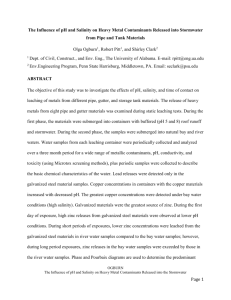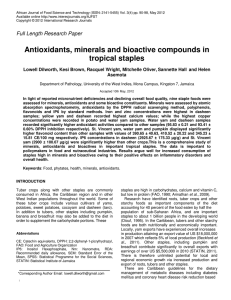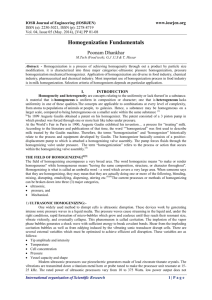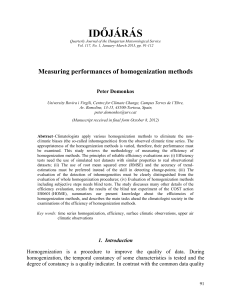gcb12243-sup-0001-DataS1
advertisement
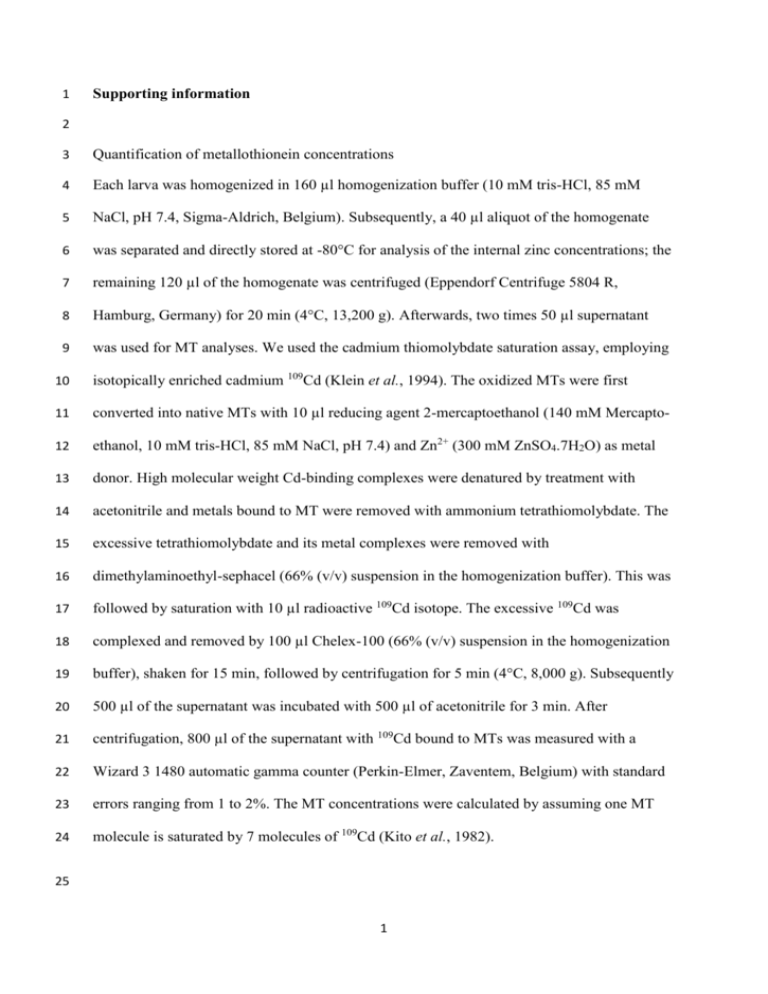
1 Supporting information 2 3 Quantification of metallothionein concentrations 4 Each larva was homogenized in 160 µl homogenization buffer (10 mM tris-HCl, 85 mM 5 NaCl, pH 7.4, Sigma-Aldrich, Belgium). Subsequently, a 40 µl aliquot of the homogenate 6 was separated and directly stored at -80°C for analysis of the internal zinc concentrations; the 7 remaining 120 µl of the homogenate was centrifuged (Eppendorf Centrifuge 5804 R, 8 Hamburg, Germany) for 20 min (4°C, 13,200 g). Afterwards, two times 50 µl supernatant 9 was used for MT analyses. We used the cadmium thiomolybdate saturation assay, employing 10 isotopically enriched cadmium 109Cd (Klein et al., 1994). The oxidized MTs were first 11 converted into native MTs with 10 µl reducing agent 2-mercaptoethanol (140 mM Mercapto- 12 ethanol, 10 mM tris-HCl, 85 mM NaCl, pH 7.4) and Zn2+ (300 mM ZnSO4.7H2O) as metal 13 donor. High molecular weight Cd-binding complexes were denatured by treatment with 14 acetonitrile and metals bound to MT were removed with ammonium tetrathiomolybdate. The 15 excessive tetrathiomolybdate and its metal complexes were removed with 16 dimethylaminoethyl-sephacel (66% (v/v) suspension in the homogenization buffer). This was 17 followed by saturation with 10 µl radioactive 109Cd isotope. The excessive 109Cd was 18 complexed and removed by 100 µl Chelex-100 (66% (v/v) suspension in the homogenization 19 buffer), shaken for 15 min, followed by centrifugation for 5 min (4°C, 8,000 g). Subsequently 20 500 µl of the supernatant was incubated with 500 µl of acetonitrile for 3 min. After 21 centrifugation, 800 µl of the supernatant with 109Cd bound to MTs was measured with a 22 Wizard 3 1480 automatic gamma counter (Perkin-Elmer, Zaventem, Belgium) with standard 23 errors ranging from 1 to 2%. The MT concentrations were calculated by assuming one MT 24 molecule is saturated by 7 molecules of 109Cd (Kito et al., 1982). 25 1 26 Quantification of internal zinc concentrations 27 In the same larvae in which the MT concentrations were measured, 40 µl aliquot of the 28 homogenate was dried at 60°C for 48 h. Subsequently, samples were digested by 200 µl of 29 highly pure acid nitric (HNO3: 70%), followed by 30 minutes incubation at 110°C in a 30 heating block. After cooling down, 10 µl hydrogen peroxide (H2O2: 30%) was added to the 31 sample. Again, the sample was incubated at 110°Cfor 30 minutes. All samples were then 32 diluted with mQ-water to exact 7 ml sample solutions. Zinc concentrations in the damselfly 33 larvae were analyzed using ICP-OES (Thermo scientific, ICAP 6300 Duo, Waltham, MA, 34 USA). Certified mussel reference material (CRM 278) of the Community Bureau of 35 Reference (European Union, Brussels, Belgium) and blanks were used to verify the accuracy 36 of the analysis. Recoveries were within 10% of the certified values. The zinc concentrations 37 of the homogenization buffer were below the detection limit (2.5 µg/l), indicating they did 38 not bias the observed zinc concentrations in the animals. 39 40 References 41 Kito H., Ose Y., Mizuhira V., Sato T., Ishikawa T., Tazawa T. (1982) Separation and 42 Purification of (Cd, Cu, Zn)-Metallothionein in Carp Hepato-Pancreas. Comparative 43 Biochemistry and Physiology C-Pharmacology Toxicology & Endocrinology, 73, 121- 44 127. 45 Klein D., Sato S., Summer K. H. (1994) Quantification of oxidized metallothionein in 46 biological-material by a Cd saturation method. Analytical Biochemistry, 221, 405- 47 409. 48 49 2


